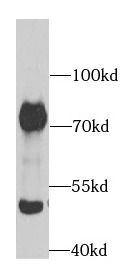Products
ACHE antibody
Category:
- SPECIFICATIONS
- Product Name
- ACHE antibody
- Catalogue No.
- FNab00083
- Size
- 100μg
- Form
- liquid
- Purification
- Immunogen affinity purified
- Purity
- ≥95% as determined by SDS-PAGE
- Clonality
- polyclonal
- Isotype
- IgG
- Storage
- PBS with 0.02% sodium azide and 50% glycerol pH 7.3, -20℃ for 12 months (Avoid repeated freeze / thaw cycles.)
Immunogen
- Immunogen
- acetylcholinesterase (Yt blood group)
- Alternative Names
- Acetylcholinesterase antibody, ACHE antibody, ARACHE antibody, N ACHE antibody, YT antibody
- UniProt ID
- P22303
- Observed MW
- 71 kDa
Application
- Tested Applications
- ELISA, WB, IHC
- Recommended dilution
- WB: 1:500 - 1:2000; IHC: 1:50 - 1:100
Validated Images
 mouse liver tissue were subjected to SDS PAGE followed by western blot with FNab00083(ACHE antibody) at dilution of 1:1000
mouse liver tissue were subjected to SDS PAGE followed by western blot with FNab00083(ACHE antibody) at dilution of 1:1000
 Immunohistochemistry of paraffin-embedded mouse brain tissue slide using FNab00083( ACHE Antibody) at dilution of 1:100
Immunohistochemistry of paraffin-embedded mouse brain tissue slide using FNab00083( ACHE Antibody) at dilution of 1:100
- Background
- Acetylcholinesterase hydrolyzes the neurotransmitter, acetylcholine at neuromuscular junctions and brain cholinergic synapses, and thus terminates signal transmission. It is also found on the red blood cell membranes, where it constitutes the Yt blood group antigen. Acetylcholinesterase exists in multiple molecular forms which possess similar catalytic properties, but differ in their oligomeric assembly and mode of cell attachment to the cell surface. It is encoded by the single ACHE gene, and the structural diversity in the gene products arises from alternative mRNA splicing, and post-translational associations of catalytic and structural subunits. The major form of acetylcholinesterase found in brain, muscle and other tissues is the hydrophilic species, which forms disulfide-linked oligomers with collagenous, or lipid-containing structural subunits. The other, alternatively spliced form, expressed primarily in the erythroid tissues, differs at the C-terminal end, and contains a cleavable hydrophobic peptide with a GPI-anchor site. It associates with the membranes through the phosphoinositide (PI) moieties added post-translationally.



